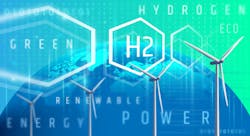Administration Announces National Clean Hydrogen Strategy
As the White House continues its goal of building a clean energy economy, on June 5 it released the U.S. National Clean Hydrogen Strategy and Roadmap.
The roadmap is a comprehensive framework for accelerating the production, processing, delivery, storage, and use of clean hydrogen—a versatile and flexible energy carrier that can be produced with low or zero carbon emissions, the White House says.
The roadmap was developed by the U.S. Department of Energy (DOE), in partnership other federal agencies, and is aligned with the President’s whole-of-government approach to addressing the climate crisis and achieving a carbon-free grid by 2035 and a net-zero emissions economy by 2050.
The Strategy and Roadmap identifies three key strategies to ensure that clean hydrogen is developed and adopted as an effective decarbonization tool, including:
- Targeting strategic, high-impact uses for clean hydrogen, which will ensure that clean hydrogen will be utilized in the highest benefit applications, where limited alternatives exist (such as the industrial sector, heavy-duty transportation, and long-duration energy storage to enable a clean grid);
- Reducing the cost of clean hydrogen by catalyzing innovation and scale, stimulating private sector investments, and developing the clean hydrogen supply chain; and
- Focusing on regional networks with large-scale clean hydrogen production and end-use in close proximity, enabling maximum benefit from infrastructure investment, driving scale, and facilitating market liftoff while leveraging place-based opportunities for equity, inclusion, and environmental justice.
Job Creation
Another aspect of the plan is that of job creation. “President Biden understands that growing America’s clean hydrogen capability can spur good-paying union jobs, support local economic development, and help decarbonize industries long seen as ‘hard to decarbonize,’” said Assistant to the President and National Climate Advisor Ali Zaidi, in a statement. “This roadmap will align the private and public sectors on a shared path to drive faster toward a cleaner, more secure energy future.”
According to DOE’s Pathways to Commercial Liftoff: Clean Hydrogen report, America’s growing hydrogen economy has the potential to add 100,000 net new direct and indirect jobs by 2030.
Benefits of Clean Hydrogen
"Clean hydrogen is set to play a vital future role in reducing emissions from some of the most energy-intensive sectors of our economy, including industrial and chemical processes and heavy-duty transportation," the report says. "Clean hydrogen can also support the expansion of variable renewable power by providing a means for long-duration energy storage and offers flexibility and multiple revenue streams for all types of clean power generation—including renewables, advanced nuclear, and other innovative technologies."
The Strategy and Roadmap provides a snapshot of hydrogen production, transport, storage, and use in the United States today and a vision for how clean hydrogen will contribute to national decarbonization goals across multiple sectors in the future, the report notes. I The report examines future demand scenarios—with strategic opportunities for the domestic production of 10 million metric tonnes (MMT) of clean hydrogen annually by 2030, 20 MMT annually by 2040, and 50 MMT annually by 2050.
It also complements a $9.5 billion investment for clean hydrogen through the President’s Bipartisan Infrastructure Law, ongoing research and development efforts across the federal government, as well as strong policy incentives—including a new production tax credit for clean hydrogen—in the Inflation Reduction Act.
About the Author
EHS Today Staff
EHS Today's editorial staff includes:
Dave Blanchard, Editor-in-Chief: During his career Dave has led the editorial management of many of Endeavor Business Media's best-known brands, including IndustryWeek, EHS Today, Material Handling & Logistics, Logistics Today, Supply Chain Technology News, and Business Finance. In addition, he serves as senior content director of the annual Safety Leadership Conference. With over 30 years of B2B media experience, Dave literally wrote the book on supply chain management, Supply Chain Management Best Practices (John Wiley & Sons, 2021), which has been translated into several languages and is currently in its third edition. He is a frequent speaker and moderator at major trade shows and conferences, and has won numerous awards for writing and editing. He is a voting member of the jury of the Logistics Hall of Fame, and is a graduate of Northern Illinois University.
Adrienne Selko, Senior Editor: In addition to her roles with EHS Today and the Safety Leadership Conference, Adrienne is also a senior editor at IndustryWeek and has written about many topics, with her current focus on workforce development strategies. She is also a senior editor at Material Handling & Logistics. Previously she was in corporate communications at a medical manufacturing company as well as a large regional bank. She is the author of Do I Have to Wear Garlic Around My Neck?, which made the Cleveland Plain Dealer's best sellers list.
Nicole Stempak, Managing Editor: Nicole Stempak is managing editor of EHS Today and conference content manager of the Safety Leadership Conference.
